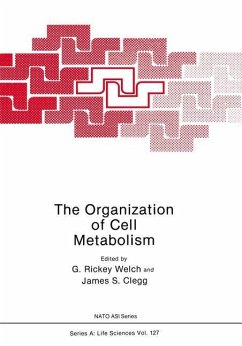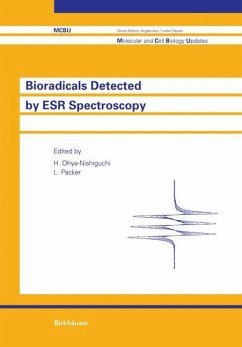
The Organization of Cell Metabolism
Proceedings of a NATO ARW held in Hanstholm, Denmark, September 4, 1985
Herausgegeben: Welch, G. Rickey; Clegg, James S.

PAYBACK Punkte
20 °P sammeln!
The NATO Advanced Research Workshop on nThe Organization of Cell n Metabolism was held 31 August - 4 September, 1985, at the Hotel Hansthol m in Hansthollllt Denmark. From areas of cell biology, bio chemistry, enzymology, and biophysical chemistry, the Workshop brought together workers whose research focuses on the character of the metabolic infrastructure of the living cell. The organizing committee was composed of the following members: James S. Clegg Douglas B. Kell Paul A. Srere G. Rickey Welch (Chairman) There has now arisen an edifice of proof that cell metabolism is highly ordered in sp...
The NATO Advanced Research Workshop on nThe Organization of Cell n Metabolism was held 31 August - 4 September, 1985, at the Hotel Hansthol m in Hansthollllt Denmark. From areas of cell biology, bio chemistry, enzymology, and biophysical chemistry, the Workshop brought together workers whose research focuses on the character of the metabolic infrastructure of the living cell. The organizing committee was composed of the following members: James S. Clegg Douglas B. Kell Paul A. Srere G. Rickey Welch (Chairman) There has now arisen an edifice of proof that cell metabolism is highly ordered in space and time. The refinement of cytological extraction methodology and the development of more gentle isolation techniques have led to the demonstration of structural organization for most of the primary metabolic pathways. Moreover, the study of isolated enzyme complexes and membranous arrays has revealed unique functional properties of the organized state. Interest in metabolic organization has heightened very recently, due to the emergence of exciting new cytochemical and electron-microscopic advances in the elucidation of the cytOOIatrix and associated cell water. The hyaloplasmic space of eukaryotic cells has now been shown to be laced with a dense network of various filamentous structures - one role of which appears to be that of a structural support for the microcompartmentation of metabolic processe~ The supramolecular organization of certain processes may exceed the physical confines of intracellular particulates, involving large-scale entrainment of the cytoplasm in space and time.














